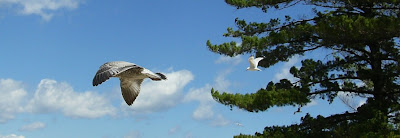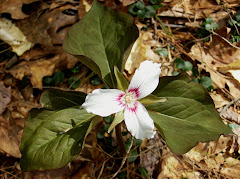 This past weekend found my brother, father and me in Deerfield at the expansive Pawtuckaway State Park. My brother has been bugging me for at least a year to get out to see the boulder fields, but the drive and the tales of a dirt road with so many bumps and pot holes at the end of the long ride always put me off. Let's just say, I was feeling adventurous this past weekend.
This past weekend found my brother, father and me in Deerfield at the expansive Pawtuckaway State Park. My brother has been bugging me for at least a year to get out to see the boulder fields, but the drive and the tales of a dirt road with so many bumps and pot holes at the end of the long ride always put me off. Let's just say, I was feeling adventurous this past weekend.The boulder "fields" were amazing. Huge remnants of an ancient ring dike formed by volcanic activity... and so hard to capture on film in a way to do their magnitude justice. Luckily, my brother makes a decent scale for perception and you'll spot him in a few of these photos.
 To call this place a boulder "field" is a little bit of a misnomer on sight. The first run of house sized boulders is in a deep, lush, apparently old growth forest. The place feels like its crawling in trolls... and maybe Orlando Bloom. But on closer inspection, I found it packed with college aged climbers with big mats and chalky hands as they moved from one boulder to the next to conquer them.
To call this place a boulder "field" is a little bit of a misnomer on sight. The first run of house sized boulders is in a deep, lush, apparently old growth forest. The place feels like its crawling in trolls... and maybe Orlando Bloom. But on closer inspection, I found it packed with college aged climbers with big mats and chalky hands as they moved from one boulder to the next to conquer them. My brother's head can be seen peeping out of this rocky cropping of boulders. This is the first real biggy you see after cresting the small glade. What I found lovely about this boulder, aside the fact that it was about 2-3 stories tall (aren't photo's deceptive?) is that a stream ran smack dab into one side of the granite and stopped in a pool there, then it bubbled forth happily on the other side, seemingly coming from solid rock. Such a granite couldn't stop a little stream from sticking to its agenda!
My brother's head can be seen peeping out of this rocky cropping of boulders. This is the first real biggy you see after cresting the small glade. What I found lovely about this boulder, aside the fact that it was about 2-3 stories tall (aren't photo's deceptive?) is that a stream ran smack dab into one side of the granite and stopped in a pool there, then it bubbled forth happily on the other side, seemingly coming from solid rock. Such a granite couldn't stop a little stream from sticking to its agenda! This is my brother poking in from a cave in the second boulder field. It was sunnier here because this field was the result of a landslide from appearance and was skirted by a peaceful, open wetland. It was nice to watch the sunlight rippling on the cave ceiling, reflected by the wetland.
This is my brother poking in from a cave in the second boulder field. It was sunnier here because this field was the result of a landslide from appearance and was skirted by a peaceful, open wetland. It was nice to watch the sunlight rippling on the cave ceiling, reflected by the wetland. That's my dad. I wonder how many other people have thought to take the same picture? :)
That's my dad. I wonder how many other people have thought to take the same picture? :) Colonial New Englanders had an infatuation with naming things after the devil. A wonderful cave in the 800 ft granite cliffside here was no exception. This is one of those shots where the sheer magnitude of the cliffs cannot be captured as we make our way to "The Devil's Den". Inside the large enclave, I felt more like this was a place where Native Americans must have sought shelter or performed seasonal rites - it had that feel to it. It also had a green fungus which glowed neon green without any light on it whatsoever.
Colonial New Englanders had an infatuation with naming things after the devil. A wonderful cave in the 800 ft granite cliffside here was no exception. This is one of those shots where the sheer magnitude of the cliffs cannot be captured as we make our way to "The Devil's Den". Inside the large enclave, I felt more like this was a place where Native Americans must have sought shelter or performed seasonal rites - it had that feel to it. It also had a green fungus which glowed neon green without any light on it whatsoever. And just to prove I was really there... I tried to get a shot of me with dad in the background at the middle boulder field.
And just to prove I was really there... I tried to get a shot of me with dad in the background at the middle boulder field.












































